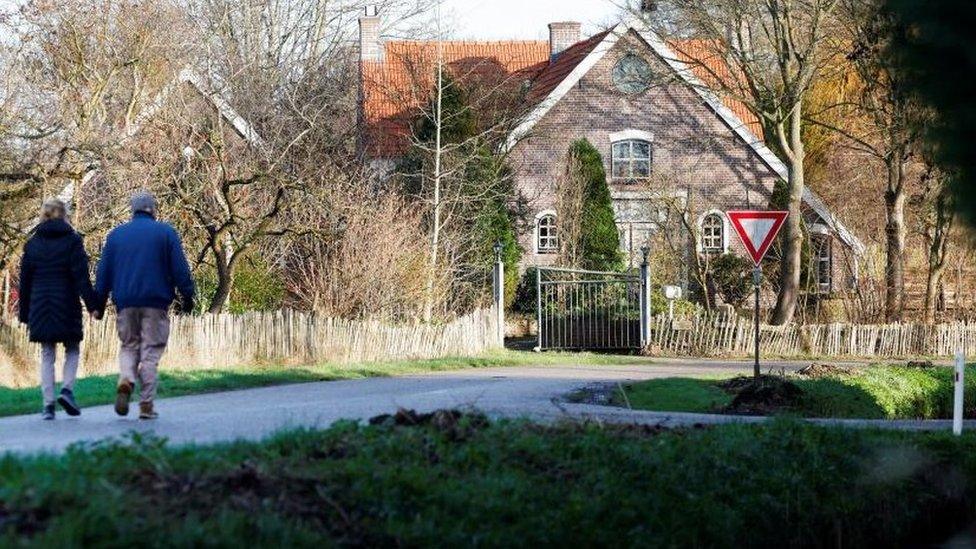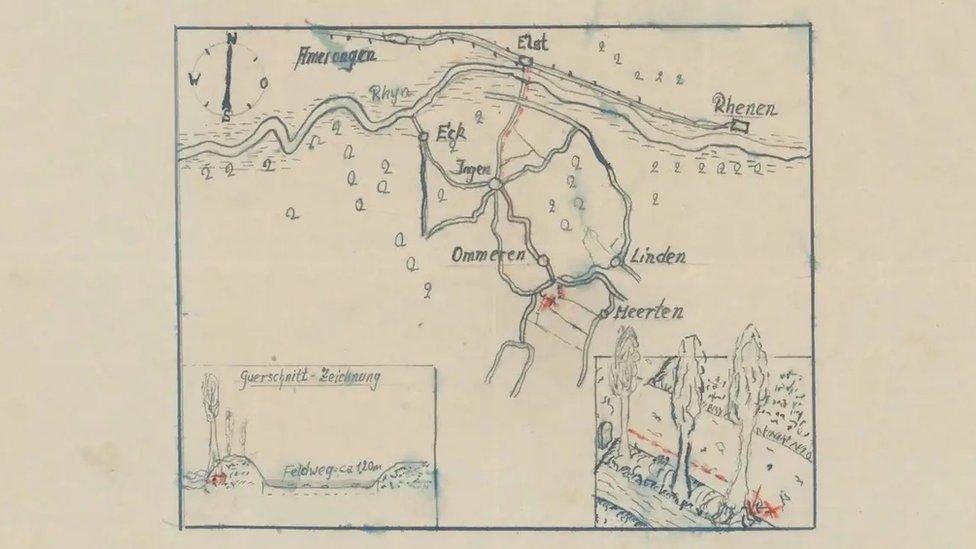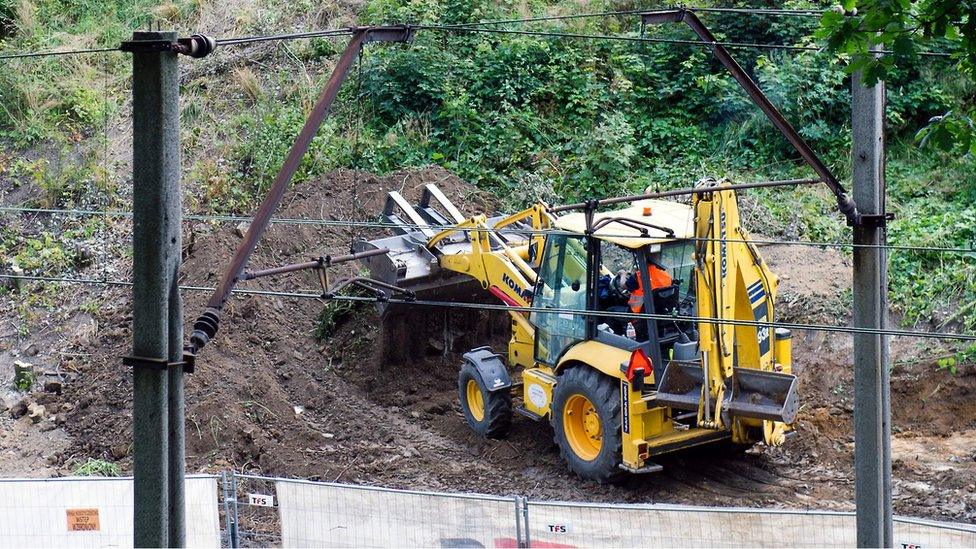Hunting for Nazi gold in a Dutch village
- Published

People have been digging in the village attempting to find treasure
Exasperated residents have appealed to treasure-hunters to stay away after they descended on the Dutch village of Ommeren searching for riches potentially worth millions, allegedly hidden by Nazi soldiers during World War Two.
The hunt was triggered by an old map, believed to reveal where German soldiers may have buried ammunition boxes crammed full of looted diamonds, rubies, gold and silver. The hand-drawn diagram complete with a red X to mark the spot is part of a case file made public by the Dutch National Archive only last week.
When the documents were released at the end of a 75-year confidentiality period, the declassified map made clear that Ommeren, in the eastern province of Gelderland, was where the treasure appeared to lie.
The village, and its red X, were near the Allied front line during Operation Market Garden in 1944, an audacious airborne attempt to create a land route into northern Germany.
Now, throughout Ommeren there is evidence of unauthorised excavations.
Discarded farming equipment which presumably activated metal detectors is strewn around freshly dug craters, gouged out of farmland and forests.
"I moved here for the peace and tranquillity," said Sander, who was out walking his dog, Bouf. "Now the whole world knows about us."

The map includes a cross-sectional drawing to help show the alleged burial site
People have been knocking on his door, asking for directions to the hidden treasure. He even saw a group of young people digging.
"This area is already rich in history," said Sander. "The white villa over there was occupied by Nazi officers. When new secrets come out, it makes people curious again."
The declassified documents, external in the archive include the testimony of a German soldier, who said that a bank in the city of Arnhem, 40km from Ommeren, was hit by a bomb in August 1944, scattering the contents of the vault - jewellery, coins, precious gems and gold watches.
Three or four occupying German soldiers pocketed what they could, he said and stashed their haul in ammunition boxes and bread packages - the most secure containers they had to hand.
Later, in the last weeks of the war, the German invaders were retreating, and, the soldiers apparently decided to bury the treasure.
After the war a Dutch institute which was set up to track down belongings expropriated by the Nazis came across the story of the young German paratrooper, identified as Helmut Sonder. He provided an eyewitness account and sketched the now well-perused map.
The potential hoard is thought to be so valuable that before the map was released the Dutch state made several attempts to dig the treasure up.
Ommeren resident Petra van Dee, 42, is furious with the Dutch National Archive for releasing the information, which has left her family feeling vulnerable and exposed.
"I cannot sleep. One of the holes they dug in my garden came up to here," she gestured to her chest.
Reporters have popped up outside her window too, wielding microphones and metal detectors on her land.
Her neighbours have been woken by strangers, with flashlights strapped to their foreheads, she claims, furiously plunging spades into their lawn after dark.
Petra wants the gold-diggers to keep their distance. "Stay away from other people's property, you have nothing to look for here," she says.
For decades the Nazi treasure map and the other documents have been buried deep in the bowels of the National Archive, where men in blue overalls push trolleys laden with folders down narrow aisles of history.
When I visited, it was humming with activity.
"We never expected this," Annet Waalkens, freedom of information adviser concedes as she prises open the dossier of evidence dating back to the 1940s.
If they'd had any inkling a treasure map would capture the public imagination and catapult Ommeren into the global spotlight, staff would have warned the municipality in advance, she assures me.

Annet Waalkens says they did not expect there to be such an interest in the map and the village
Metal detectors were recently banned in Ommeren, as there is a real risk of amateur excavators hitting unexploded World War Two grenades, bombs or landmines.
Fortunately, no injuries have been reported, but a number of fines have been issued and even if anyone were to find gold, they would be obliged to declare it and hand it over to the local authority which owns the land.
While the plot might seem to rival a riveting adventure novel, it is also a reminder of the realities of a conflict that claimed 50 million lives, among them six million Jews who were murdered in the Holocaust.
"With every wartime story, there comes tragedy," Annet Waalkens at the National Archive points out. "And in this case, it reminds us of the story of the people of cities like Arnhem, losing everything they had, including their valuables."
The documents in the archives contain no mention of who the rightful owners might be. Most likely it was local people who had placed the items in the Arnhem bank, wanting to protect their wealth from the Nazis. Much of the property pillaged from Jewish families in the Netherlands was stored in a bank in Amsterdam.

Alexander says he has no interest in joining the treasure hunt in his village
Dutch archivists say they have found no evidence that the German paratrooper who sketched the map has died. Therefore, their assumption is that Helmut Sonder - who would now be 98, according to the documents - may hold the key to unearthing this treasure trove.
The riches have never been found, at least not to public knowledge, and according to the Dutch Archives the four most likely explanations are:
Helmet Sonder was lying. However, his testimony was extensively fact-checked, and found to be credible
Someone living nearby, or possibly one of the German soldiers, came back and recovered the loot before authorities caught wind of it
An employee from the Dutch institute made use of inside knowledge and secretly returned in between the failed official attempts to find it
Two American officers, spotted near disturbed earth, could also have made off with the booty.
In the aftermath of the war, investigators concluded the loot was worth pursuing because it was estimated to be worth millions.
Dutch authorities believe, that even if the elusive treasure trove did ever exist, it's probably long gone.
Some villagers contend the case of the missing Nazi treasure is pure fairy tale.
Bouncing his rosy-cheeked toddler, Alexander chuckles at the international spotlight on Ommeren. "I guess we are famous now."
But he has no interest in joining the treasure hunt. "I have my treasure over there," he nods to his wife and daughter, "I have no need for millions."
Related topics
- Published21 September 2021

- Published16 August 2016

- Published23 January 2022
